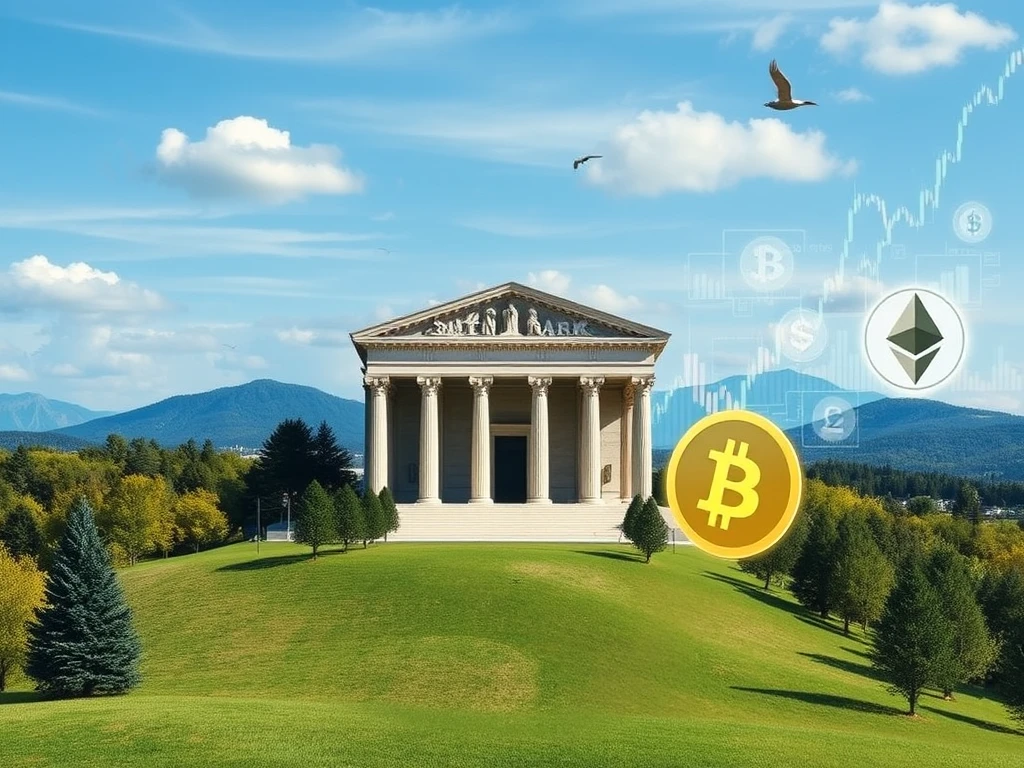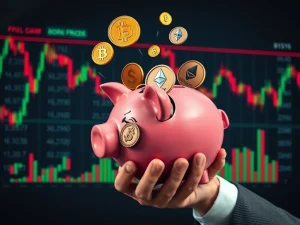Quantitative Easing Explained: How This Powerful Policy Shapes Crypto Markets

Ever wonder why Bitcoin suddenly soared after major economic events? A key factor is often quantitative easing (QE). This powerful tool used by central banks has a profound, though sometimes indirect, impact on the cryptocurrency world. Understanding QE is crucial for anyone navigating the crypto landscape.
What is Quantitative Easing and How Does it Work?
Quantitative easing is a monetary policy tool employed by central banks, especially when traditional methods like lowering interest rates are no longer effective. It gained prominence during the 2008 financial crisis when economies needed a stronger boost.
The primary goal of QE is to stimulate economic activity by increasing the money supply. This encourages banks to lend more freely and makes borrowing cheaper for businesses and individuals. The central bank achieves this by purchasing assets, typically government bonds or other securities, from commercial banks and financial institutions.
While sometimes described as “printing money,” QE doesn’t involve creating new physical cash. Instead, it increases the amount of digital money held in bank reserves. This extra liquidity isn’t cryptocurrency; it’s conventional money created by the central bank, intended to flow into the economy through increased lending, boosting spending and investment.
QE can also influence asset prices, like stocks and bonds, as the increased money supply seeking returns drives up demand.
How Quantitative Easing Works: A Step-by-Step Guide
Understanding how quantitative easing works involves looking at the sequence of actions taken by the central bank and their ripple effects through the economy. It’s a chain reaction designed to inject liquidity and lower borrowing costs.
Here’s the typical process:
- Asset Purchases: The central bank buys government securities (like Treasury bonds) and sometimes other assets from banks and financial firms.
- Injecting Liquidity: The central bank pays for these assets by adding money to the accounts these banks hold at the central bank. This floods the financial system with cash.
- Lowering Interest Rates: With more cash reserves than required, banks are more willing to lend to each other and to customers. This increased supply of credit tends to drive down interest rates across the board.
- Boosting Lending & Spending: Cheaper borrowing costs encourage businesses to invest and expand, and consumers to take out loans for purchases. This increased activity stimulates economic growth.
Quantitative Easing in Practice: Real-World Examples
Quantitative easing isn’t just theory; it has been a go-to tool for major central banks facing economic downturns. Here are some notable instances:
United States (Post-2008 Financial Crisis & COVID-19)
Following the 2008 housing crash and subsequent recession, the Federal Reserve (the Fed) implemented multiple rounds of QE (QE1, QE2, QE3). They purchased trillions in government bonds and mortgage-backed securities to lower long-term interest rates and stabilize the financial system.
Again, during the COVID-19 pandemic in 2020, the Fed rapidly reintroduced QE, buying assets at a pace of $120 billion per month at its peak. This aimed to keep borrowing costs low and provide support to businesses and households amidst widespread shutdowns.
Japan (Early 2000s & Post-2013)
Japan was an early adopter of QE, using it in the early 2000s to combat persistent deflation and slow growth. The Bank of Japan (BoJ) bought government bonds and later expanded purchases to include exchange-traded funds (ETFs) and real estate investment trusts (REITs).
Eurozone (2015–2022)
The European Central Bank (ECB) launched its large-scale asset purchase program (APP) starting in 2015 to counter low inflation and stimulate the economy following the sovereign debt crisis. The ECB bought government and corporate bonds from eurozone countries to lower borrowing costs.
How QE Impacts Crypto Markets: A Closer Look
The QE impact on crypto markets is a topic of significant interest for investors. When central banks pump vast amounts of liquidity into the financial system through QE, some of this money often finds its way into riskier or alternative assets, including cryptocurrencies like Bitcoin and altcoins.
This influx of liquidity can drive up asset prices across various markets. Additionally, as the supply of traditional fiat currency increases, concerns about inflation or currency devaluation can grow. This prompts some investors to seek out assets perceived as hedges or stores of value outside the traditional financial system.
Bitcoin, with its fixed supply and decentralized nature, is often viewed in this light, similar to digital gold.
Consider the period during the aggressive US Fed QE response to COVID-19 in 2020:
- Bitcoin was trading below $5,000 in March 2020.
- By late 2021, its price had surged past $60,000.
Factors contributing to this growth during the QE era included rising inflation expectations and low interest rates in traditional finance, pushing investors towards alternatives. The search for a store of value independent of central bank policies was a major driver.
Thus, QE can indirectly contribute to crypto market rallies by influencing investor behavior, increasing overall market liquidity, and highlighting the potential benefits of decentralized assets during times of fiat expansion.
The Flip Side: When Quantitative Easing Ends
Just as QE can support asset prices, the end of QE or the move towards quantitative tightening (QT) can have the opposite effect. When central banks reduce asset purchases or start selling assets, liquidity is withdrawn from the financial system. This makes borrowing more expensive and can reduce the appetite for riskier investments.
For example, when the US Fed began QT in 2022 to combat rising inflation, the crypto market experienced a significant downturn. Bitcoin’s price dropped substantially throughout that year as investors shifted to safer assets and overall market liquidity tightened due to rising interest rates and balance sheet reduction.
Quantitative Easing vs. Quantitative Tightening: What’s the Difference?
QE and QT are opposite sides of the same monetary policy coin. Understanding their differences is key to grasping central bank actions.
| Feature | Quantitative Easing (QE) | Quantitative Tightening (QT) |
|---|---|---|
| Central Bank Action | Buys assets (e.g., government bonds) | Sells assets or lets them mature without reinvesting |
| Impact on Money Supply | Increases money supply (injects liquidity) | Decreases money supply (withdraws liquidity) |
| Goal | Stimulate economy, lower interest rates, encourage lending during downturns | Cool down economy, control inflation, raise interest rates (indirectly) during overheating |
| Central Bank Balance Sheet | Expands | Contracts |
| Market Effect | Tends to push asset prices up, lower borrowing costs | Tends to push asset prices down, raise borrowing costs |
Is Tapering the Same as Quantitative Easing?
No, tapering and QE are related but distinct. Quantitative easing is the act of the central bank actively buying assets to inject money. Tapering is simply the *slowing down* of those asset purchases. It’s the initial step towards ending QE, not a reversal or the start of QT itself, though it signals QT may follow.
Is the Fed Still Tightening or Easing in 2025?
As of April 2025, the US Federal Reserve is navigating a complex economic situation. While not fully in an easing phase, they have begun moderating their quantitative tightening efforts. The Fed has maintained its benchmark interest rate range but reduced the pace at which its balance sheet shrinks by lowering the monthly runoff cap for Treasury securities. Projections suggest potential interest rate cuts later in 2025, indicating a cautious shift in monetary policy based on economic conditions and inflation trends.
Pros and Cons of Quantitative Easing
QE is a powerful tool with significant benefits but also notable risks:
Pros:
- Economic Stimulation: Boosts activity by increasing money supply and encouraging lending/investment.
- Lower Borrowing Costs: Drives down interest rates, making loans cheaper for consumers and businesses.
- Deflation Prevention: Helps support demand and price stability, preventing a harmful spiral of falling prices.
Cons:
- Inflation Risk: Excessive money supply increase can devalue currency and fuel inflation.
- Asset Bubbles: Easy money can inflate asset prices (stocks, bonds, real estate, potentially crypto) beyond their fundamental value.
- Policy Challenges: Adds to central bank balance sheets, potentially complicating future efforts to manage inflation or interest rates.
Conclusion: QE’s Enduring Impact
Quantitative easing is a non-traditional monetary policy tool used by central banks to stimulate the economy during crises by injecting liquidity through asset purchases. While effective in lowering borrowing costs and encouraging activity, it carries risks like inflation and asset bubbles. Its impact extends beyond traditional finance, significantly influencing risk assets, including the crypto market. Understanding QE and its counterpart, quantitative tightening, is vital for interpreting central bank actions and their potential effects on your investments in the dynamic world of cryptocurrency.








